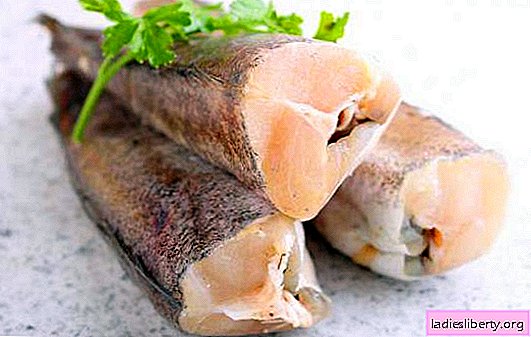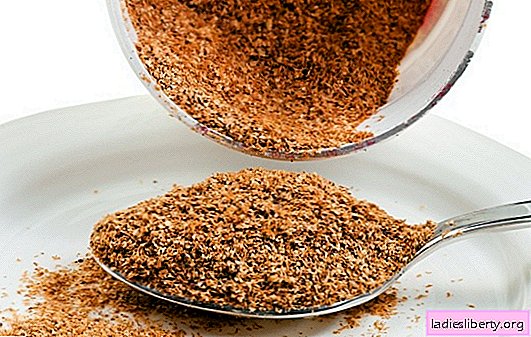
The valuable commercial hake fish is very tasty, but, unfortunately, less known than its cod relatives. But hake is a real storehouse of nutrients and eating dishes from it turns into tangible benefits for the whole body.
The main thing is to know how to choose a quality fish, how to cook it deliciously and at what indications it is most useful, and in which cases a hake is harmful.
What substances affect hake
There are more than a dozen varieties of this carnivorous deep-sea fish, but their differences are important only to ichthyologists and traders, since they are practically equivalent in taste and useful qualities.
The mineral series in the hake is represented by fluorine, copper, sulfur, nickel, potassium, chlorine, phosphorus, chromium, calcium, magnesium, iron, manganese, iodine, molybdenum, zinc, sodium, chromium, cobalt. With an average portion of a dish of hake fillet, up to 50-130% of the daily intake of individual minerals can enter the human body.
Of the vitamins in hake, PP, C, E, A and the group of vitamins B (B1, B2, B6, B9, B12) are most fully represented.
Along with salmon and pinagor, hake meat and especially its caviar are valuable sources of polyunsaturated omega-3 fatty acids necessary for the proper functioning of the cardiovascular system. The protective properties of omega-3 with respect to the development of hypertension and varicose veins are also known.
What is the use of hake for those who follow the figure
Hake fillet is easily, quickly absorbed and does not burden the body with calories - there are only 86 per 100 g of raw fish. 100 g of boiled hake - 93 kcal, baked or stewed - about 95 kcal, fried - 105 kcal. Being a low-calorie product, hake, in addition, prevents the accumulation of fat in problem areas of the figure and therefore often appears in the diet menu.
What diseases will the hake benefit from?
Regular use of hake, in principle, has a positive effect on the state of the entire human body, but, like many other products that are distinguished by uniquely balanced complexes of vitamins, minerals and other substances, there are areas of health that are especially noticeable for hake.
It is recommended to be included in the weekly diet for diseases:
Digestive system;
· Reproductive system;
Mucous membranes;
Skin integument;
· And with hormonal disruptions.
But his medicinal properties are not limited to this:
· Hake dishes for diabetes are useful for two reasons - they are not difficult for the digestive tract, contain a minimum of calories and fat, and also lower blood sugar;
· The composition of the fish fillet manifests itself as an antioxidant, contributing to the elimination of toxins and free radicals from the body, as well as the full renewal of blood;
· As a seafood with a high iodine content, hake is useful for thyroid diseases;
· Soon after the introduction of the hake in the weekly diet, the metabolism approaches the norm;
· Hake contributes to the speedy return of health to normal after infectious diseases;
· A number of scientists also speak about the theoretical benefits of this fish for the prevention of cancer;
· Hake dishes, by the way, are ideally elegantly served (for better psychological perception), it is recommended to include in the diet during depressions and severe stresses. The hake has a positive effect on sleep, normalizing it, driving off insomnia.
How to choose and cook fish to benefit from hake
The second name of the hake on the shelves is hake.
The size of the fish varies from 20 to 90 cm, and the weight rarely exceeds 3 kg.
When buying chilled fish, you should evaluate the freshness of its smell, the sparkle of the eyes and the fact that when pressed on the fillet, the fossa from the finger should disappear without a trace.
But a fresh hake for sale is good only near the places where it is caught, since long-term storage in a chilled form reduces its taste.
Frozen hake goes on sale gutted whole carcasses or pieces of fillet. Dry (shock) freezing most fully retains the benefit of the hake.
If you are choosing a hake covered with ice, you need to evaluate the following:
· The size of the fish should correspond to its weight. Too heavy - an excess of frozen water wasted the price of a hake and spoiled the structure of his meat, tearing the fibers. Suspiciously light - it means that it has accumulated and moisture from the meat has evaporated, so it will be tasteless and dry;
· Crooked, curved fish, most likely more than once was defrosted and frozen, and this completely deprives the hake of high palatability and many useful properties.
Small bones are present in the hake, but, after heat treatment of the fish, sirloin plates are easily separated from them and the ridge.
White, not very dense hake meat, many find it is more tender, fatty and juicy than cod or pollock meat. Hake can be deliciously prepared according to recipes for mackerel, pollock and cod, and can also be combined in the fillet of these fish.
Remembering that hake meat is rather dry in itself, when frying, you should choose a batter or a thick layer of breadcrumbs for it, when baking, place in a foil or cooking sleeve, a layer of dough, moisten with sauce or broth. With any cooking method, hake does not lose useful properties. They prepare fish soup, fish pies, meatballs, stews with him.
Possible harm to the hake and contraindications to its use
The advantages of this fish are excellent, but there are also disadvantages expressed in the potential harm of the hake that it can bring, and in contraindications to its use.
· It is not recommended to eat a lot of hake for constipation, since it is rich in iron, and it, with an excess in the body, can strengthen them;
· A contraindication to the presence of hake on the table is gastritis with high acidity and an ulcer, as this fish easily increases the acidity of gastric juice;
· Naturally, you can not use hake with individual intolerance to seafood.
Heavy metals and other contaminants entering the oceans as a result of human activities tend not only to dissolve in water, but also to accumulate in lower marine life, for example, algae and crustaceans. And further along the food chain, harmful substances are found in commercial fish, some of which, for example, cod, are distinguished by the ability to accumulate them in a rather large amount.
Unfortunately, the origin of the hake is often impossible to determine at all, but it can be assumed that large suppliers of fish fish it in ecologically clean areas. You can still choose a hake grown in artificial conditions.
But with any doubts about the quality of the fish, it should not be too abundantly included in the diet of children, pregnant and lactating women, the elderly and those who are greatly weakened by disease.
Like almost all fish, a hake needs to be cooked thoroughly by heat treatment to prevent harm from the hake, from which fillets can be infected with parasites. Also, it is better to cook a homemade salting hake according to special recipes that reduce the risks of parasite infection. Often this means a long, strong ambassador.
Connoisseurs of healthy nutrition should pay attention to the fact that many seafood producers use food additives and stabilizers to improve the quality of frozen food - to preserve water in it, preserve its shape, and extend its shelf life, finally. Many of the additives are officially approved, such as E452, but much remains to be seen regarding their safety in humans.











